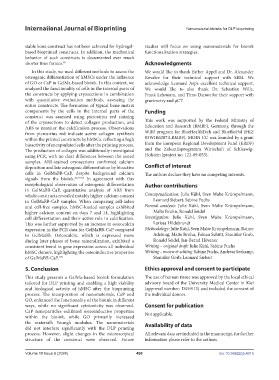Page 498 - IJB-10-6
P. 498
International Journal of Bioprinting Nanomaterial-bioinks for DLP bioprinting
stable bone construct has not been achieved for hydrogel- studies will focus on using nanomaterials for bioink
based bioprinted constructs. In addition, the mechanical functionalization strategies.
behavior of such constructs is documented over much
shorter time frames. 80 Acknowledgments
In this study, we used different methods to assess the We would like to thank Esther Appel and Dr. Alexander
osteogenic differentiation of hMSCs under the influence Kovalev for their technical support with SEM. We
of GO or CaP in GelMa-based bioink. In this context, we acknowledge Lennard Arp’s excellent technical support.
analyzed the functionality of cells in the internal parts of We would like to also thank Dr. Sebastian Wille,
the constructs by applying cryosections in combination Frank Lehmann, and Timo Damm for their support with
with quantitative evaluation methods, assessing the gravimetry and µCT.
entire constructs. The formation of typical bone matrix
components by the cells in the internal parts of the Funding
construct was assessed using picrosirius red staining
of the cryosections to detect collagen production, and This work was supported by the Federal Ministry of
ARS to monitor the calcification process. Observations Education and Research (BMBF), Germany, through the
from picrosirius red indicate active collagen synthesis WIR! program for BlueHealthTech and BlueBioPol (FKZ
within the printed constructs by hMSCs, reflecting a high 03WIR6207A.BMBF). MOIN CC was founded by a grant
bioactivity of encapsulated cells after the printing process. from the European Regional Development Fund (ERDF)
The production of collagen was additionally investigated and the Zukunftsprogramm Wirtschaft of Schleswig-
using PCR, with no clear differences between the tested Holstein (project no. 122-09-053).
samples. ARS-stained cryosections confirmed calcium
deposition and late osteogenic differentiation by bioactive Conflict of interest
cells in GelMaBB-CaP, despite background calcium The authors declare they have no competing interests.
signals from the bioink. 42,97,99 In agreement with this
morphological observation of osteogenic differentiation Author contributions
in GelMaBB-CaP, quantitative analysis of ARS from
whole constructs revealed notably higher calcium content Conceptualization: Julie Kühl, Sven Malte Krümpelmann,
in GelMaBB-CaP samples. When comparing cell-laden Leonard Siebert, Sabine Fuchs
and cell-free samples, hMSC-loaded samples exhibited Formal analysis: Julie Kühl, Sven Malte Krümpelmann,
higher calcium content on days 7 and 14, highlighting Malte Bruhn, Ronald Seidel
cell differentiation and their active role in calcification. Investigation: Julie Kühl, Sven Malte Krümpelmann,
This was further supported by an increase in osteocalcin Larissa Hildebrandt
expression in the PCR data for GelMaBB-CaP compared Methodology: Julie Kühl, Sven Malte Krümpelmann, Rainer
to GelMaBB. Osteocalcin, which is expressed more Adelung, Malte Bruhn, Fabian Schütt, Stanislav Gorb,
during later phases of bone mineralization, exhibited a Ronald Seidel, Jan-Bernd Hövener
consistent trend in gene expression across all individual Writing – original draft: Julie Kühl, Sabine Fuchs
hMSC donors, highlighting the osteoinductive properties Writing – review & editing: Sabine Fuchs, Andreas Seekamp,
of GelMaBB-CaP. 109 Stanislav Gorb, Leonard Siebert
5. Conclusion Ethics approval and consent to participate
This study presents a GelMa-based bioink formulation The use of human tissue was approved by the local ethical
tailored for DLP printing and enabling a high viability advisory board of the University Medical Center in Kiel
and biological activity of hMSC after the bioprinting (approval number: D459/13) and included the consent of
process. The incorporation of nanomaterials, CaP and the individual donors.
GO, enhanced the functionality of the bioink in different
ways, while no significant cytotoxicity was observed. Consent for publication
CaP nanoparticles exhibited osteoinductive properties Not applicable.
within the bioink, while GO primarily increased
the material’s Young’s modulus. The nanomaterials Availability of data
did not interfere significantly with the DLP printing
process. However, slight changes in the microscopical All relevant data are included in the manuscript, for further
structure of the construct were observed. Future information please refer to the authors.
Volume 10 Issue 6 (2024) 490 doi: 10.36922/ijb.4015

